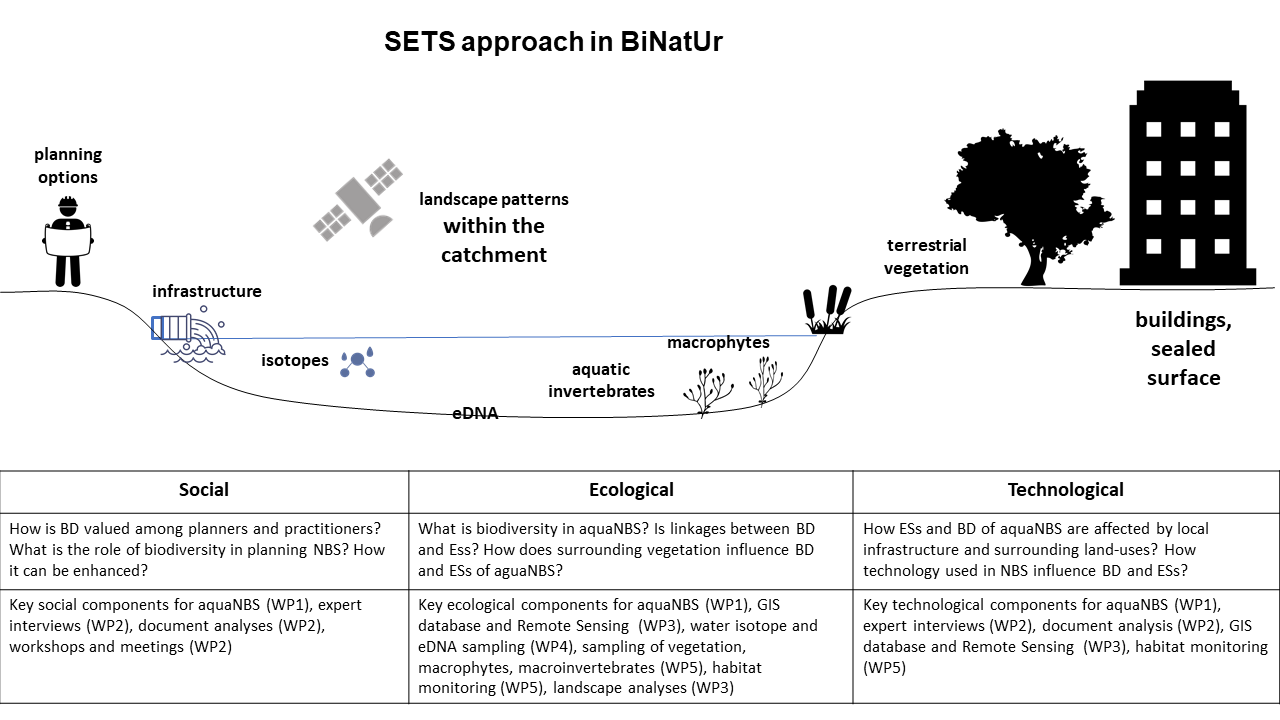Nature-based solutions as part of climate smart cities
Climate change has significant effects on water quantity, quality and seasonal variation in cities. It increases the risk of flooding and erosion in urban areas. Nature-based solutions in aquatic environments ("aquaNBS"), such as wetlands, streams or stormwater ponds, have been implemented in many European cities, but their ability to mitigate climate change while increasing the diversity of urban nature has been little studied. In the BiNatUr project, we study the biodiversity of aquaNBS solutions and its connections to ecosystem services in five European cities (Antwerpen, Berlin, Helsinki, Lisbon and Poznań). The goal of the project is to improve the design, construction and maintenance of aquaNBS in a direction that takes natural diversity into account. Our research is based on social-ecological-economic systems (SETS) thinking and it also frames our most important research questions.
Species diversity of nature-based solutions and regulating ecosystem services
BiNatUr focuses on four questions: (1) How do different social, ecological and technological factors affect biodiversity in aquaNBS, (2) how do these factors vary between cities and regions? (3) How does biodiversity affect the regulating ecosystem services of aquaNBS, and (4) how how to plan, build and maintain aquaNBS that support biodiversity?
Our project consists of five interconnected work packages: In the WP1 we develop the SETS framework so that it supports and guides research in our project. In addition, WP1 produces recommendations and guidelines to support planning and maintenance of biodiversity-friendly aquaNBS. In the WP2 we engage with local stakeholders, conducts expert interviews and makes document analyses for the climate and biodiversity strategies and goals of the participating cities. WP3 implements landscape analyzes using existing remote sensing and other materials in order to determine the effects of land use in the catchment area and the surrounding environment of 12 study sites in five cities (totally 60 sites). WP4 will quantify and characterize regulating ES of selected 60 aquaNBS by using an integrated tracer approach of stable water isotopes (deuterium, oxygen). We will sample precipitation, surface water, water from aquaNBSs and groundwater as well as effluents from sewers and wastewater treatment plants (if nearby), plus plant xylem water of the terrestrial vegetation in each city. In the WP5 we will monitor biodiversity (macrophytes, macroinvertebrates, algae, diatoms) within 12 aquaticNBS in five cities. Water samples are collected for eDNA (diatoms and algae) and stable isotope analyzes (WP4). In addition, our project has a coordination work package.

SETS framing for BiNatUr research questions. © Kati Vierikko
Stakeholder engagement and communication
The BiNatUr project works closely with city authorities and those who are in charge of developing aquaNBS from the beginning of the project. 12 study sites in each city for biodiversity monitoring and water samplen collections (WPs 4 and 5) are selected in cooperation with key stakeholders. In addition, we regularly organize meetings and field trips to engage with relevant stakeholders. Material produced in WP1 (recommendations and guidelines) are procuded also in local language to attract target audience in five countries. During the project, we will also write several blog posts on our project website: www.bringingnatureback.com.